 In a large multi-disciplinary collaboration between partners in Sierra Leone, Nigeria, USA, and Europe, we have published our first study on Lassa virus evolution. The paper – which appears on the front page of the August issue of Cell – is the result of seven years of work on Lassa fever across West Africa.
In a large multi-disciplinary collaboration between partners in Sierra Leone, Nigeria, USA, and Europe, we have published our first study on Lassa virus evolution. The paper – which appears on the front page of the August issue of Cell – is the result of seven years of work on Lassa fever across West Africa.
The ongoing epidemic of Ebola virus disease in West Africa reminds us how little is known about biosafety level-4 viruses. Like Ebola virus (EBOV), Lassa virus (LASV) can cause hemorrhagic fever with case fatality rates in excess of 50%. Unlike EBOV, however, LASV is endemic in Nigeria, Sierra Leone, Guinea, and Liberia, leading to severe disease in tens of thousands of people each year.
In a recently released study in the journal Cell, we generated a genomic catalog of almost 200 LASV sequences collected from clinical and rodent reservoir samples. Based on this dataset, we obtained unique insights into the origins and evolutionary dynamics of this devastating virus. We show that while Ebola epidemics are usually sustained by human-to-human transmissions, LASV infections mainly result from reservoir-to-human infections. In other words, whereas most Ebola patients get infected from other Ebola patients, Lassa patients are mostly the result of independent spill-over events from the rodent reservoir.
We also used this data to elucidate the likely spread of LASV across West Africa and show that this migration was accompanied by changes in LASV genome abundance, fatality rates, codon adaptation, and translational efficiency. By investigating intrahost evolution, we found that mutations accumulate in epitopes of viral surface proteins, suggesting selection for immune escape. It is our hope that this genomic catalog will serve as a foundation for the development of vaccines and diagnostics.
Highlights
• Lassa virus is a life-threatening pathogen that is endemic in West Africa
• Lassa virus has diverse and ancient origins in Nigeria
• Viral strains from Nigeria and Sierra Leone differ in their translation efficiency
• The virus evolves within hosts to evade immune-determined selection pressures
Abstract
The 2013–2015 West African epidemic of Ebola virus disease (EVD) reminds us of how little is known about biosafety level 4 viruses. Like Ebola virus, Lassa virus (LASV) can cause hemorrhagic fever with high case fatality rates. We generated a genomic catalog of almost 200 LASV sequences from clinical and rodent reservoir samples. We show that whereas the 2013–2015 EVD epidemic is fueled by human-to-human transmissions, LASV infections mainly result from reservoir-to-human infections. We elucidated the spread of LASV across West Africa and show that this migration was accompanied by changes in LASV genome abundance, fatality rates, codon adaptation, and translational efficiency. By investigating intrahost evolution, we found that mutations accumulate in epitopes of viral surface proteins, suggesting selection for immune escape. This catalog will serve as a foundation for the development of vaccines and diagnostics.
Links
Paper in Cell
Cover of Cell
Press Release from NIH
Press Release from Scripps Research
News Release from The Broad Institute
News Release from Harvard University
PodCast from SciDevNet [starts at 21:55]
Video Abstract


